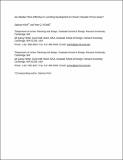Are master plans effective in limiting development in China's disaster-prone areas?

View/
Published Version
https://doi.org/10.1016/j.landurbplan.2012.12.001Metadata
Show full item recordCitation
Kim, Saehoon and Peter G. Rowe. 2013. Are master plans effective in limiting development in China's disaster-prone areas? Landscape and Urban Planning 111: 79-90.Abstract
The effectiveness of urban master plans in limiting development in a disaster-prone area of China was empirically investigated by measuring cities’ land-cover changes against their master plans. If a master plan serves as guidance for urban polices that reduce property loss from earthquakes, floods, landslides,land subsidence, and rises in sea level, it will substantially limit urban development in areas at riskfrom environmental hazards. An environmental risk map weighted toward valuable forms of land cover was generated using geospatial databases of China’s Yangtze River Delta region. Based on this data, the effects of five master plan measures—ring-road patterns, block size, the area of urban built-up lands, the locations of industrial sites, and preservation zoning—were tested using the multiple regression method.
Cities showing a high degree of compliance, in particular with preservation zoning, had a smaller amountof urban land located in high-risk zones, on average, by 14 km2. Among the top ten cities exposed to disproportionately high risks, eight were towns and only two were cities like Huzhou and Kunshan.
Terms of Use
This article is made available under the terms and conditions applicable to Open Access Policy Articles, as set forth at http://nrs.harvard.edu/urn-3:HUL.InstRepos:dash.current.terms-of-use#OAPCitable link to this page
http://nrs.harvard.edu/urn-3:HUL.InstRepos:10671400
Collections
- GSD Scholarly Articles [110]
Contact administrator regarding this item (to report mistakes or request changes)


